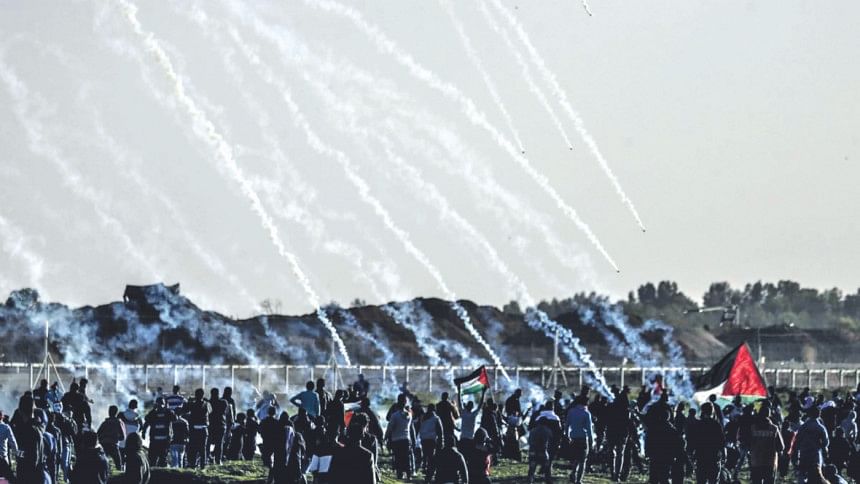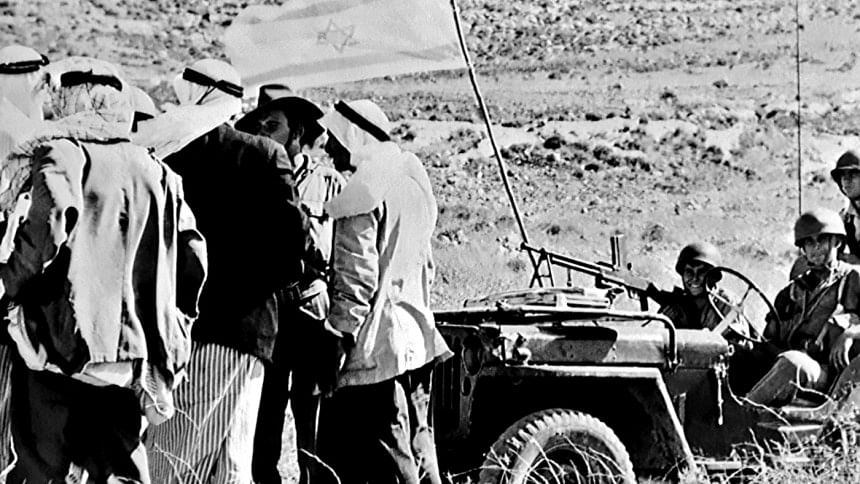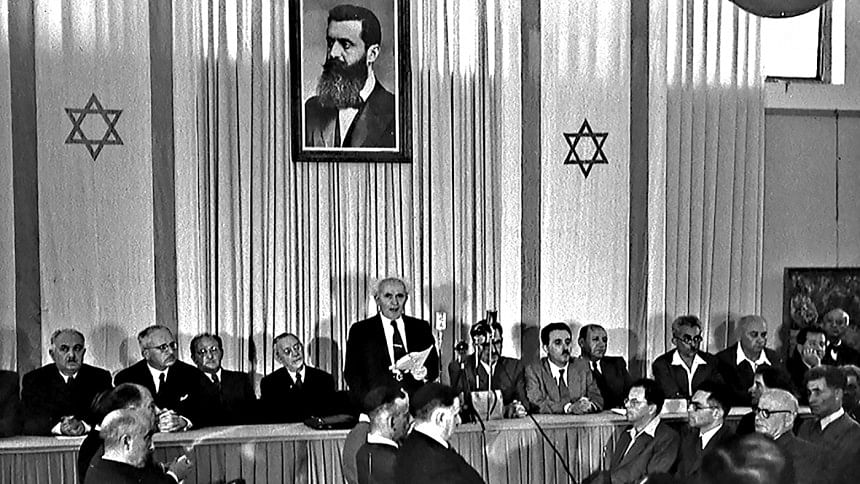Occupied Palestine and the Greater Israel Project

November 29 marked the 72nd anniversary of UN Resolution 181 (II) to end the British mandate in Palestine and the historic decision to partition Palestine and establish, after a transition period, "Independent Arab and Jewish States and the Special International Regime for the City of Jerusalem." For the Palestinians, this was the origin of the "Nakba" (catastrophe).
Israel's 1947-48 Nakba against the Palestinian people "was and remains one of history's great crimes," according to Jewish author Stephen Lendman. Another Jewish author, Illan Pappe, describes it as "The Ethnic Cleansing of Palestine" in the title of his book.
This campaign of ethnic cleansing by Israeli settlers against the Palestinians began from the very beginning of the conflict. In 1947, 800,000 Palestinians were forcibly removed and driven out from their homeland, while many thousands were murdered in cold blood. In a six-month campaign beginning in late 1947, 531 Palestinian villages were destroyed along with 11 urban neighbourhoods in cities like Tel-Aviv, Haifa and Jerusalem. To this day, Israel has never been held accountable for these crimes or the ones it was to commit over the next seven decades.

Palestinians who were originally displaced from their homes in 1948 are still refused their right to return to their homes by Israel, despite the fact that as a condition for admission to the UN in 1949, Israel had accepted UN Resolution 194, which stipulates that Palestinians who fled or were expelled during the Israeli takeover of 1947-1949 in Palestine, have the right to return to their homeland. This denial by Israel inspired the campaign called the Great March of Return which was launched on March 30, 2018, demanding that Palestinian refugees and their descendants be allowed to return to the land they were displaced from in what is now Israel.
During this year's Great March, Israeli army snipers shot 293 Palestinians dead and wounded 7,000 more. 20,000 Gazans were injured by other weapons used by Israeli armed forces, including hundreds of children and medical personnel who were trying to help the wounded and thus were specifically targeted.
The UN reported that many of the wounded were shot in their legs, which according to the Israeli army, is showing "restraint" on its part. Israel bombed hospitals and blockaded the importation of medical supplies into Gaza while also not allowing Gazans to leave the enclave for medical treatment in other parts of the Middle East.
In the absence of Gaza having proper medical facilities due to Israel's blockade, more than 120 amputations have had to be performed this year. Jami McGoldrick, the UN Humanitarian Coordinator for the Occupied Territories explained: "You've got 1,700 people who are in need of serious, complicated surgeries for them to be able to walk again...[requiring] very, very serious and complex bone reconstruction surgery over a two-year period before they start to rehabilitate themselves."
In spite of all this and the countless other crimes committed by Israel against the Palestinians for over seven decades now—and Israeli violation of numerous other international laws—one of the main reasons why action against Israel has not been possible in the UN is because of the immense backing Israel continually receive from powerful western countries, especially the US. And although supporting Israel has been a constant US policy—regardless of who occupied the office of the president in the US—ever since assuming office, US President Donald Trump has confirmed in no uncertain terms his support for Israel including Israel's illegal settlements. This is in complete contradiction to UN Security Council Resolution 2334, which says that settlements established by Israel in the occupied West Bank of Palestine is illegal.

Moreover, the Trump administration has also expressed its recognition of Israeli sovereignty over Syria's Golan Heights—also occupied illegally by Israel under international law. According to nearly all pundits, Trump's "Deal of the Century"—portions of which is yet to be made public—is supportive of the "Greater Israel" project, which also consists in the derogation of Palestinians' "right to return" by "naturalising them as citizens of Lebanon, Jordan, Syria, Iraq, and elsewhere regionally where they reside."
The concept of a "Greater Israel", according to the founding father of Zionism Theodore Herzl, is a Jewish State stretching "From the Brook of Egypt to the Euphrates." Therefore, it is not shocking to see why Israel has slowly and strategically grabbed more and more lands from its neighbours—it is to make the Greater Israel project a reality. However, here it is important to keep in mind that the Greater Israel design is not strictly a Zionist Project for the Middle East, but as many experts and academics have pointed out over the years, is an integral part of US foreign policy which aims to extend US hegemony as well as fracture and balkanise the Middle East.
The policy being pursued by the US in the region goes hand in hand with the Yinon Plan—an Israeli strategic plan to ensure regional superiority—and is simply a continuation of an earlier ploy employed by Britain in the Middle East. The Yinon Plan insists that Israel must reconfigure its geopolitical environment through the balkanisation of the surrounding Arab states into smaller and weaker states.

According to Israeli strategists, Iraq was their biggest tactical challenge as far as Arab states were concerned, and was outlined as the centrepiece of the balkanisation programme aimed at the Arab world. In Iraq, on the basis of the concepts of the Yinon Plan, Israeli strategists had called for the division of the country into a Kurdish state and two Arab states, one for Shiite Muslims and the other for Sunni Muslims. The first step towards establishing this was a war between Iraq and Iran, which the Yinon Plan discussed. Funnily enough, it was the US that had encouraged Iraq to attack Iran in line with that and armed it with chemical weapons, before turning on Iraq, demonising its leadership and eventually invading and toppling its government.
The Atlantic in 2008, and the US military's Armed Forces Journal in 2006, both published widely circulated maps that closely resembled the outline of the Yinon Plan. Aside from the division of Iraq, which the Biden Plan, named after Vice President Joe Biden during President Obama's tenure, also called for, the Yinon Plan proposes the division of Lebanon, Egypt and Syria. The plan also suggests that Iran, Turkey, Somalia and Pakistan be similarly partitioned, all to ensure Israeli dominance in the region—and US hegemony resulting from that.
According to award-winning writer, Mahdi Darius Nazemroaya, "Although tweaked, the Yinon Plan is in motion and coming to life under the 'Clean Break'," a policy document written in 1996 by Richard Perle and the Study Group on "A New Israeli Strategy Toward 2000" for the Prime Minister of Israel, Benjamin Netanyahu. The 1996 Israeli document proposes "rolling back Syria" sometime around the year 2000 or afterward by pushing the Syrians out of Lebanon and destabilising the Syrian Arab Republic—which has been happening since 2011, and even before that according to some experts of that region.

The document states: "Israel can shape its strategic environment, in cooperation with Turkey and Jordan, by weakening, containing, and even rolling back Syria. This effort can focus on removing Saddam Hussein from power in Iraq—an important Israeli strategic objective in its own right—as a means of foiling Syria's regional ambitions." As a first step towards creating an Israeli-dominated "New Middle East" and encircling Syria, it proposed the removal of president Saddam Hussein from power in Baghdad, and seven years later, we had the whole "Iraq has WMD" myth circulated around the world to justify the invasion of Iraq and to have Saddam Hussein removed from the head of the Iraqi government.
Returning to the issue of Palestine, president Trump has come up with what he calls the "Deal of the Century in order to find a final settlement between Israel and Palestine, a deal that has already been rejected by the Palestinians. According to the current US Secretary of State Mike Pompeo, many have expressed their doubts over the US peace plan which is why even he admitted that it may fail. While speaking to Jewish leaders in New York, Pompeo said that he understands the "perception" of the plan as "a deal that only the Israelis could love" and admitted that some may deem the plan "unexecutable" and "it may be rejected". If that is indeed the case, then why did the US propose such a plan?
The truth is, while pretending to seek a fair settlement to the problem, Israel and the US strategy has always been, and still is, to never grant the Palestinians any compromise, but to continue the occupation as long as necessary, while acting as if it is the fault of the Palestinians that the two sides cannot come to an agreement. And the reason why neither Israel nor the US is looking for any real end to the conflict is because as long as the conflict lasts, Israel can continue to be an aggressor against its neighbours and pursue its ambitions for regional dominance under the guise of "defending itself", all the while using Palestinian territory as a launching pad to gain even more territory.
Ultimately, the US and Israel are, in their own ways, looking to fulfil their hegemonic ambitions in the region and bring about the realisation of the Greater Israel Project. And the Palestinians, unfortunately, are simply collateral damage in the way of achieving that as far as the Israelis and the Americans are concerned.
Eresh Omar Jamal is a member of the editorial team at The Daily Star. His Twitter handle is: @EreshOmarJamal

 For all latest news, follow The Daily Star's Google News channel.
For all latest news, follow The Daily Star's Google News channel. 



Comments